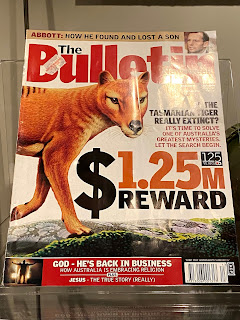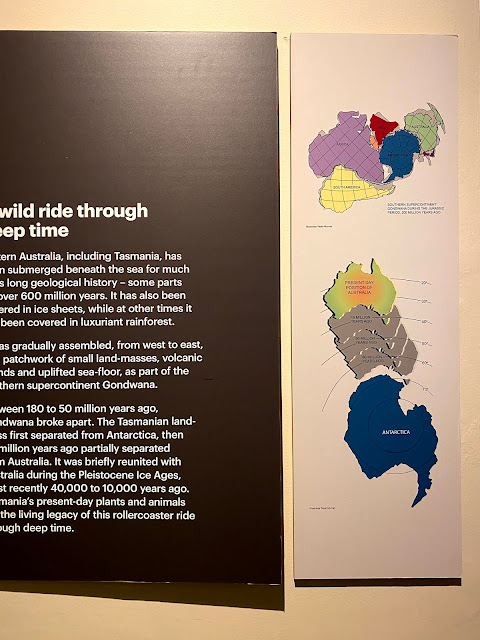Faro at MONA, the Museum of Old and New Art in Hobart, Tasmania.
James Turrell's Unseen Seen takes place inside the egg.
James Turrell's Unseen Seen takes place inside the egg.
I was supposed to hop an hourlong flight to Tasmania, but the Jetstar gods did not cooperate. With temperatures of 100º, our plane computer went into hot box mode on the runway. We pulled into the shade to cool off, but our pilots had been working long hours, so they had to be replaced. Then we waited for someone to sign off on the paperwork. Then...the crew had to be replaced too, so we had to disembark with our bags, and they threatened us on the PA if we yelled at the gate agents.
Who could have anticipated this, except anyone who's ever managed a project?
So I got to Hobart 9 hours after leaving the Nunnery, after a lunch of overpriced airport nuts and an espresso martini (yes, that's a thing) and a small can of sour cream and chives Pringle's. On the bright side, everyone was calm and polite and well-behaved including the 4-year-old next to me, on her way to visit grandma in the hospital.
But enough of that. You came for koala pictures.
It's too late for Tasmanian tigers. Which weren't actually tigers.
Lucienne Rickard is spending an entire year drawing functionally extinct birds at the Tasmanian Museum. And then erasing them. In case you felt what you're doing was hopeless...
(Okay, not this car.) I drove over the terrifying undivided winding bridge into Hobart at dusk with oncoming traffic inches to my right without screaming too loudly.
Montacute boutique hostel lives up to its name.
Located in the historic Battery Point neighborhood, Montacute is surrounded by houses with lacy terraces and blooming roses and cottages that look like they're made of gingerbread.
I spent some time at the Tasmanian Museum puzzling over how the continents used to be smushed together. Half a billion years ago, Tasmania was attached to North America, and Australia wasn't.
The end results is a lot of really cool rocks and gemstones.If you figure it out, let me know.
Tasmania was a penal colony, which you'll hear a lot more about later this week. But in recent years, Hobart has become inexplicably cool. It was probably always quite beautiful but isolated. Twenty years ago average weekly wages were around AUS$600 and round-trip airfare to Melbourne cost more than that, so it was something you did once a year. Discounted flights have fixed that. I paid less than 1/2 that, at holiday fares.
And then there was MONA, the Museum of Old and New Art, which put Hobart on the map. David Walsh made his money in casinos, and collected eclectic art, and this is his gift to Tasmania. You descend into MONA, which is mostly subterranean. There are lots of subliminal-ish words projected everywhere, like these, which flash onto a waterfall.
They give you an old iPhone with headphones and a location-sensitive app named O that maybe I'll write a blog post about, if I get really bored on vacation.
Simon Denny has an amusing and provocative temporary exhibit called Mine, which features a life-sized update to Monopoly, where each space is sponsored by a real energy company.
If you point your phone at the scanner bar codes, you get sponsored ad videos. You're asked to take a photo for your profile (I refused).
It reminded me of a recent visit to the Glass Room exhibit in San Francisco.
At the center, you duck under the archway and are scared to see...yourself.
This sofa responds when you touch it. It vibrates and giggles as you sit on it, and purrs. It's in a section with content warnings about suggestive materials.
You wander through the museum through tunnels and staircases and elevators.
Here and there, you discover sparkly grottoes by Randy Palombo.
A lot of the work is by famous artists like Nam June Paik; this is her depiction of Abraham Lincoln.
A curator added me to the queue on the app, and I managed to find my way back when my ticket turned gold. Only one person can walk out at a time. The museum guide shows you a tablet with some rules on it that you agree to, without reading.
What you don't know until then: the black is oil. It is not a pier. You are sunken, with a shoulder-height wall, surrounded by oil. From above, the oil reflects the skylight above, giving an illusion of depth. It's pretty fantastic. More on Richard Wilson's 20:50

But I came to MONA for Turrell. And Turrell did not disappoint.
When you get to the other side, you're in Faro restaurant, with a view of the Derwent River! (The first picture in this post.) When you return, the color may have changed. Later it was pale yellow.
You climb a staircase inside the white dome and lie down on a puffy bed. They give you a panic button. It's like a small planetarium dome; the original models, like the one at LACMA, were more like MRI tables.
And for 13 or 14 minutes, the "sky" changes hues and flickers and now and then the sound of voices from the restaurant, where they have Iberico ham for AUS$25, drifts in.
Then the door opens, with the river rushing by, and a friendly and earnest young guide ushers you to a dark corridor and shows you a map on an iPad. They all introduced themselves (Tristan? Amy?), friendly Tasmanians.
You descend into darkness and follow a zig zagging corridor to a cushy chair. For 14 minutes, you sit in absolute darkness. Nothing happens. And eventually your perception fills in the blanks. It's easy to drift, but good to try to stay focused. By the end, I "saw" the outlines of a geodesic dome all around me, like a black on black coloring book, the structure of MONA revealed. The art of Turrell is about slowing down your perception enough that you begin to notice and sometimes fill in the canvas.
As I was leaving, I noticed a crowd watching this tattooed man, sitting.



































Wow....not at all what I would have expected a museum in Tasmania to be. Seeing it in a new light, so to speak. Thanks.
ReplyDeleteWhat a magical experience.
ReplyDelete